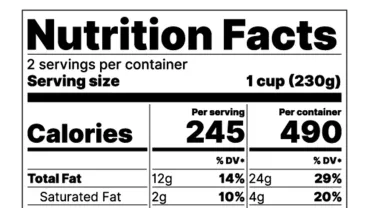A pragmatic iteration of Food Compass, a nutrition guidance system developed by researchers at the Food is Medicine Institute at the Friedman School of Nutrition Science and Policy at Tufts University, has been created that will allow the system to generate nutrition scores based on widely available Nutrition Facts and ingredients list information. A new study, published March 28 in The American Journal of Clinical Nutrition, describes how researchers created the new system.
The Food Compass is a food rating tool that classifies the healthfulness of any food, beverage, or meal on a scale from 1 (low) to 100 (high). The algorithm, known as Food Compass 2.0 (updated from the original), considers 54 different factors that influence the health benefits or drawbacks of a food, including its macronutrients, vitamins, minerals, food ingredients, processing, and additives. The system has been validated against health outcomes and can be used to create food policy and guide individual consumers to make healthier choices, said Eden Barrett, a research fellow at the Food is Medicine Institute and the Australia-based George Institute for Global Health.
But the full version of the Food Compass faced a barrier: For many everyday food products, there simply isn’t enough information available to calculate the score. “Anything in the supermarket is unlikely to have all 54 of those nutrition factors,” Barrett said, adding that a food’s Nutrition Facts panel and ingredients list usually provides about 18 of the 54 attributes included in the Food Compass calculation.
The researchers worked to craft a pragmatic version of the algorithm to fill in the gaps. “We needed to develop a way to compute a score using only information that is regularly available,” Barrett said. So, they created Food Compass 10—a version able to generate accurate Food Compass scores based on commonly available nutritional information.
To do this, the research team leveraged the Nutrition Facts panel and the ingredients list, available on all packaged foods and beverages in the United States and many other countries. Key nutrients were obtained from the Nutrition Facts panel, and the ingredients list was extracted and used to match missing nutritional information to similar ingredients with known Food Compass scores across more than 150 food categories. The known scores for each ingredient were averaged to approximate a score for the food with the missing data.
Because the tool is more pragmatic, the final score for each food product is rounded to range from 1 (low) to 10 (high)—called the “Food Compass 10.”
Researchers tested Food Compass 10 scores against the full Food Compass and validated that the new version was scientifically sound, Barrett said. Ninety percent of the 500 foods that the team tested with Food Compass 10 were within one point of their (rounded) full Food Compass score. “The scores were all still very close to each other,” Barrett said.
The Food Compass team has made the Food Compass 10 algorithm publicly available and believes that Food Compass 10 offers a practical way to rate the healthfulness of food choices at the grocery store.
“We hope supermarkets, online retailers, food manufacturers, and even restaurants will look at Food Compass as an easy to understand and validated system that helps people make better choices,” said Dariush Mozaffarian, senior author on the paper and director of the Food is Medicine Institute. “Our goal is to help people achieve their goals around healthy eating.”
